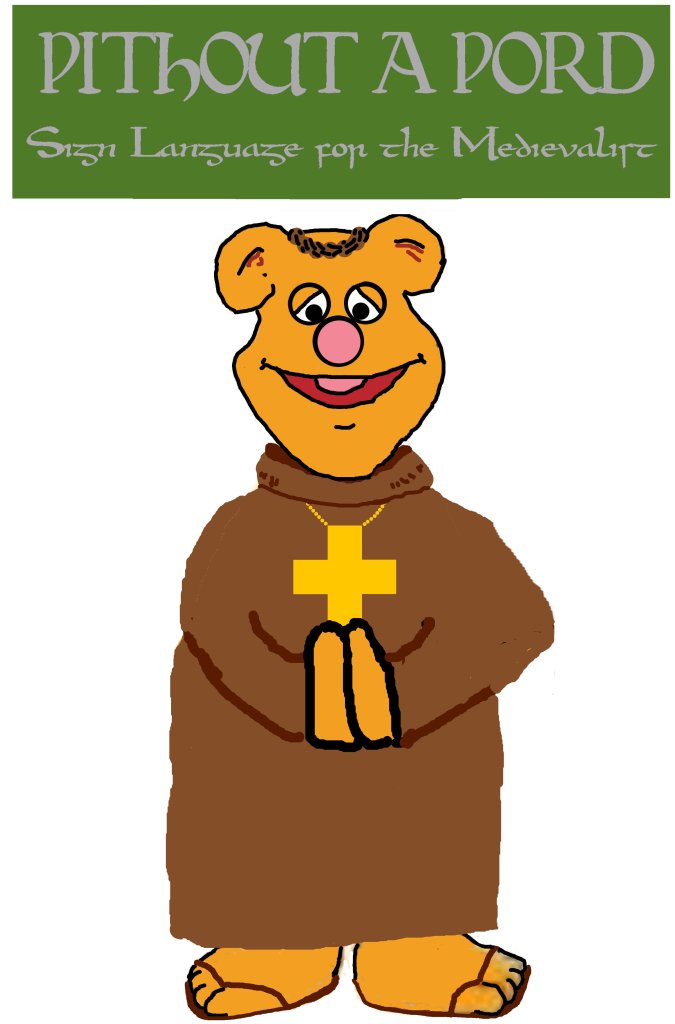WITHOUT A WORD V: CHEESE
Monastic sign language has been used in Europe from at least the tenth century by monks of the Benedictine Order because “silence is a virtue.” // // It was a method using a hand lexicon to name certain commonplace things without speaking aloud. It is not a language, per sé, like ASL, though very useful. This article was inspired by Debby Banham’s The Anglo-Saxon Monastic Sign Language.

When you would like cheese, set your two hands flat together, as if pressing.
DEFINITIONS FOR LIVING HISTORY
For Kael Ball whose comment on farb an acronyms caused me to finish this post!
Some of these terms you might be familiar with. Others unfamiliar. As Lynn Bloom says, “Everyone new to a group…has to learn its code, in language and in behavior, as part of the initiation process. This is how we enter and become part of a discourse community.” Here are a few terms that that you will encounter in reenactments:
AO
Authenticity (or Accuracy) Officer, who is given the power to decide on the historical accuracy of an item.
Boffer
Mock combat with foam weapons.
Farb
Anything inaccurate, first seen in American Civil War reenacting in the 1960s. Origins are uncertain, but it may come from the phrase, “Far Be It for Me to Criticize, But…”
First Person
An impassions where you pretend to be from another time and behave in that manner, so that you do not know anything that happened after the date of your impression.
Frog and Feathers
French and Indian.
Jubbly
Anything not period accurate. The word originated as the name of a British orange drink in the 1950s, and it was later popularized as street slang. One theory is that its use in reenacting described someone who dresses as though they came from a jumble (yard) sale.
Kit
The possessions of a reenactor that might have been owned by his impression. A kit may be dictated by military regulations or merely be objects that a person of a particular time might have owned. Battle kit is a term often used to describe a fighter’s uniform, armor and arms.
MoP
Member of the Public; a spectator.
Period
i) An abstract term referring to historically authentic dress, mannerisms, etc.; ii) being in the style of an historical period.
Ramada Ranger
A reenactor who stays in a hotel instead of camping.
Reenactorism
Modern invention that is accepted and promoted as accurate to the period though if it is not.
Retro Research
Creating an artifact without doing research and then trying to find documentation that will justify it.
Ropeline
i) The real or imaginary line between which everything should be historically accurate.
Public Hours; ii) the times when the historical accuracy behind the Ropeline must be adhered.
Second Person
An impression where you present yourself as a person from another time, but you can break impression to comment on things that happened after the date of your impression. Also knownas a ghost impression.
Thenty
Accurate, coming from the term “authentic.”
Third Person
An impression where you present yourself as a person of the present and, therefore, know things after the date of your impression.
Three-Foot (or Three-Foot etc.) Rule
Something seems accurate at three feet, or any designated distance.
ACRONYMS UNIQUE TO LIVING HISTORY
A selection of acronyms not necessarily restricted to a single era! Feel free to contribution new an d additional acronyms!
Acronyms are everywhere nowadays, and many acronyms have vastly varying meanings. These are not necessarily universally used reenactors. But probably should be!
ACW
American Civil War
AO
Authenticity Officer
AWI
American War of Independence
BM
British Museum
CRAP
Can’t Really Actually Provenance
CW
Colonial Williamsburg
DA
Early Middle Ages. From the discredited term “Dark Ages”
ECW
English Civil War
LHE
Living History Exhibit
MA
Master at Arms or Middle Ages
MoP
Member of the Public (a MoPpet is a young Member of the Public)
MTA
Military Training Officer
SHITS
Seriously Hideous Inauthentic Trash
TAPS
Thick As Pig Shit
VA
Viking Age or Albert and Victoria Museum
VMA
Viking Middle Ages
ESSENTIAL TOOLS
Having access to or possessing certain items is essential. Having a loom, a desk or a work table is certainly essential. However, even more essential are those minor tools that can be easily transported and used. The fabled Mästermyr tool chest is an example of a traveling artisan who certainly had to borrow—or construct—a place where these tools can be used.
The following are essential, to be certain and should work for most basic activities, but they are just a start! All these tools were chosen because they were so often seen that they were ubiquitous and small enough to be easily held and transported.
Agriculture
Axe
Hoe
Mallet/Mall
Rake
Shovel
Sickle/Scythe
For a more complete list of what tools might be owned, consult the list in “The Discriminating Reeve” to choose what might be of use.
Cooking
Knife (Large)
Pot (metal or Stone; a tripod or trivet is also recommended, though a temporary surface of some sort can be made with stones)
Spoon (Large)
Leatherworking
Awl
Cutting tool (Sharp Knife or Shears)
Needle
Metalworking Tools
Hammer
Tongs
Textiles
Needle
Pins
Shears, Scissors or Snips
Spindle Whorl and Stick
Weapons
Spear
Woodworking Tools
Axe
Hammer (a Mall type, not a specialist hammer)
Tongs (also known as Pliers)
Wedge (metal or wood)
I have recounted above the basic tools needed for those activities with which I am accustomed. If there is an activity with which you are familiar that is not mentioned here (or a tool for one of these activities you find essential but mentioned here), please let me know!
